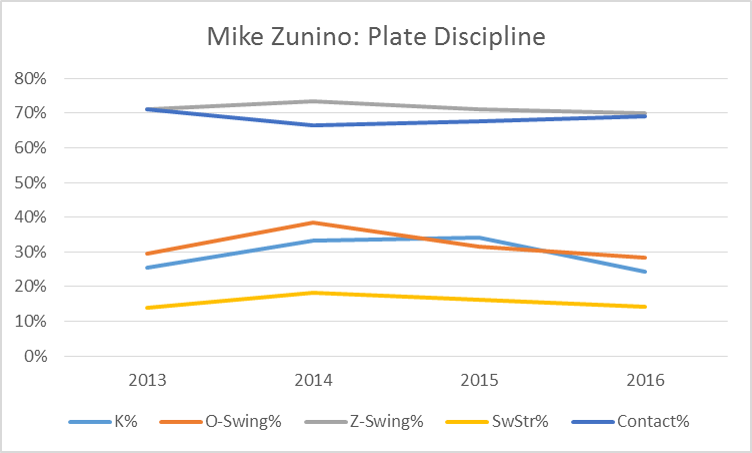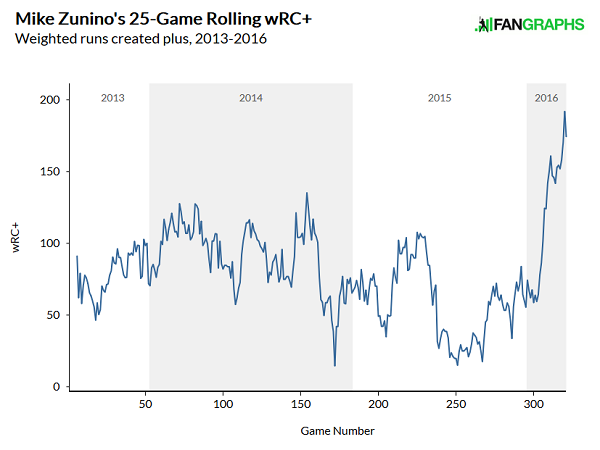Mike Zunino’s Subtle Changes and Not-So-Subtle Results
Mike Zunino won the M’s another ball game last night with a late 3-run dinger. He crushed a pitch over the right field wall after laying off a two-strike slider the pitch before. It was, as many pointed out on twitter afterwards, a perfect encapsulation of how 2016 Mike Zunino differs from the 2015 version, who may recall was one of the worst hitters in recent memory. The transformation feels comprehensive, universal; it feels like he’s a completely different hitter thanks to a huge spike in walk rate, a drop in K%, the power surge, etc. Every aspect of his offensive production seems remade, whether by savvy player development, or the same dark magic that turned James Paxton into a Canadian Noah Syndergaard. And yet, the more you dig deeper, the smaller those changes appear.
Jeff’s got a great piece on his improvementat Fangraphs today, and he looks both at the staggering numbers Zunino’s put up thus far, and also a potential mechanical tweak to his swing: instead of a small stride forward, he’s keeping his front leg on the ground and transferring his weight without so much movement in his lower half. He also points out that Zunino’s giving away fewer at-bats by being more selective on 0-2 and 2-strike counts, as he did in last night’s game. Eno Sarris tweeted last night that he thinks a big part of Zunino’s surge has come from a bit more selectivity on breaking balls, regardless of the count, pointing to this Brooks chart of his whiff% by pitch types. Both of these explanations are probably factors in the drop in Zunino’s K rate and the dramatic improvement in his walk rate, but I’m still struck by just how subtle the changes look when you drill down to peripheral stats.
Here’s a chart with a bunch of those peripherals. Here’s Zunino’s K rate, his O-swing rate (swings at balls), Z-swing rate (swings at strikes), his SwStr rate (whiffs) and his contact rate (duh).

There are encouraging signs, no doubt, particularly in K%, which we knew already. But there’s no massive transformation in his contact rate – he had a very low contact rate in 2015, and has a very low contact rate in 2016, too. Against fastballs, Zunino had one of the worst whiff rates in the game in 2015. Aaaand he’s still got one now! One of his many problems last year was that he couldn’t deal with high fastballs, and even swung and missed at about a quarter of fastballs *thrown right down the middle*. None of that’s changed this year, and he’s actually whiffing on *more* middle-middle fastballs now. How does this line up with the chart Jeff used showing the change in Zunino’s *production*? (I’ll copy and paste that here):

I initially thought that Zunino was learning to recognize different pitches, and that he was able to drive breaking balls instead of being absolutely flummoxed by spin. But in looking at his 2015 data, he actually slugged .500 against sliders last year – much, much better than he did against fastballs. He’s hit sliders well thus far in 2016, but despite a poor batting average against them, that was about the only thing he did *right* a year ago. I wondered how much of this was BABIP driven, but that doesn’t look like it either. His BABIP was awful last year, and while it’s better, it’s still not great – that just hasn’t hurt him because it excludes all of the glorious dingers Zunino’s mashing. Was it platoon related? Doesn’t look like it thus far.
It occurred to me that my entire approach to this problem was centered in looking at which of Zunino’s weaknesses he’d eliminated or improved. I don’t know for sure, but I’m starting to wonder if that wasn’t the default approach the last M’s player development group took too – O-swing’s too high in 2014, so they made an adjustment and lo and behold, Zunino’s O-swing was better in 2015. But whatever change they made *also* sapped his power and saw him take too many called strike threes.* This year, he’s taking even *more* called 3rd strikes, so the M’s new approach probably isn’t centered on reducing the myriad things Zunino struggles with at the plate. Instead, I think they’re focusing on what he does well.
Mike Zunino’s got an uppercut swing, and always has since he came into the league. In 2015, Zunino had the 4th lowest GB/FB ratio in MLB (out of 268 hitters w/more than 300PAs), surrounded by sluggers like Chris Carter, Lucas Duda and Brandon Moss. In 2016, it’s still among the lowest in the game. This helps explain why Zunino sometimes struggles against elevated fastballs, but it also means he should hit well against low pitches. *Should* hit well. In 2015, Zunino’s slugging percentage on contact with pitches in the lower third of the zone and below (the “low pitches” definition I used a lot in the posts about Safeco Field) was all of .293, or just about dead on his season SLG% of .300. Given the problems with high stuff, Zunino needs to clobber these pitches, and he was utterly unable to do so a year ago. It makes some sense, given that the lower the vertical location of a pitch, the more likely it is to turn into a grounder. To be fair, Zunino’s average launch angle on such pitches (11.7 degrees) exceeded the league average (6.8), showing that his uppercut helped him avoid some grounders. But too often, it led to pop-ups and lazy fly balls. How about in 2016? Thus far, Zunino is slugging *1.000* on contact with low pitches, with an even better launch angle of 15.7 (league ave. now = 7.6). Over half of his HRs have come on pitches in this zone, and he’s added some low-ball doubles, too. This, to me, seems like the critical part of the change: Zunino looks for pitches in his zone, and looks to ^$&*ing destroy them. If the ball isn’t in that zone, he may still struggle – he’ll swing through a fastball, get caught in-between on a good change, etc., but that’s true of everyone. What I think Zunino’s done, presumably with the M’s encouragement, is to focus on what he *does* do well, and his uppercut is a great weapon in a league where pitchers are throwing more and more low pitches, trying to take advantage of the new, lower strike zone. To be clear: laying off 2 strike chase pitches is a big part of this. You can’t hit the big 3-2 HR if you strike out on the 2-2 slider. But simply laying off tough pitches is *not* the key part of what Zunino’s doing. Annihilating the ball is the key part. Forget trying to “defend” with 2 strikes, forget trying to “stay alive” or advance the runners – Zunino’s never going to have enough pure bat-to-ball skill to do that. Zunino needs to find pitches he can drive and drive them, and maybe that’s all he needed to hear.**
* There was some work at BP, Fangraphs and BTBS a few years back on an expected K rate, using things like SwStr% as inputs – essentially, what would you expect the K rate of a guy with these peripherals to be? Given the big improvements in those metrics, particularly O-Sw%, you’d have imagined Zunino’s K% would’ve dropped markedly in 2015, and dropped more than the comparatively tiny improvements Zunino made from 2015 to 2016. But that’s not what we see at all, which I think strengthens the case that 1) Zunino was utterly, completely messed up last year, and probably guessing on most every pitch and 2) the most important “fix” is destroying pitches in his zone, and not worrying so much about trying to defend against pitcher’s pitches.
** I was talking about Zunino last night on twitter with two of my favorite baseball internetters, Brendan Gawlowski of BP and Lookout Landing and Kyle Boddy of Driveline Baseball. While we’re in agreement that the M’s PD group should get a huge amount of praise for these changes, we had a bit of a debate over what caused his slide from 2013 to 2015 – Kyle/Brendan think most/nearly all of his problems can be traced back to the disastrous decision to promote him in 2013 after less than a full year in the minors. To me, that clearly played a role, but something else must’ve played a role in the collapse of 2015 – from K% to ISO to walk rate, everything got much, much worse. I’m not really sure if that’s right, but it’s the kind of season that just cries out for additional explanation – something like that shouldn’t happen to anyone, least not someone with a season and a half of big league experience, but Brendan and Kyle are smarter than me, and may be completely right that it’s all driven by his initial struggles, and the inability to work on them out of the public eye. Anyway, one of the things that Kyle’s always tweeting about is the importance of “intent” for pitchers. That is, working on one’s fitness and mechanics to the point where you’re physically capable of directing 100% of your effort into a pitch (and doing so safely, repeatably, etc.). I keep coming back to that concept when I watch Zunino stalk and smash pitches these days, and think about how that’s essentially the polar opposite of going to the plate focused on a series of things to avoid (“Don’t chase the low-away slider; watch out for the high fastball; 2-2 pitch, maybe look change and react to FB?; he struck you out on Y last time, so protect against that, etc.”).
Comments
3 Responses to “Mike Zunino’s Subtle Changes and Not-So-Subtle Results”
Leave a Reply
You must be logged in to post a comment.

It does seem like the Zunino redemption story is an example of why the ability to manage people, and understand what might motivate them, is always going to be an essential part of the baseball landscape.
The idea that Zunino needed to get back to focusing on what he did WELL, instead of trying to avoid all of the things he struggled with, is a powerful one. We’ll probably never know the real answer, and hopefully he’s able to maintain a decent fraction of this level of performance, but I’m just glad that he escaped from what appeared to be a rapidly crashing career trajectory.
The extra excitement probably comes from the fact there is so much room for improvement from the catcher slot that Mike doing well is such a potent thing for fixing a hole in the lineup and making the Mariners better immediately.
I’ve been commenting all month on Zunino’s improved OBP and incredible walk rate. It’s exciting because you literally *have* to try taking more pitches in order to walk that much.
It is demonstrative of his improvement. Perhaps even more importantly : it confirms his willingness to work hard and (especially) be coached.
Great analysis and a wonderfully fresh/different take than Jeff or others’ articles on Z’s turnaround. Thanks!